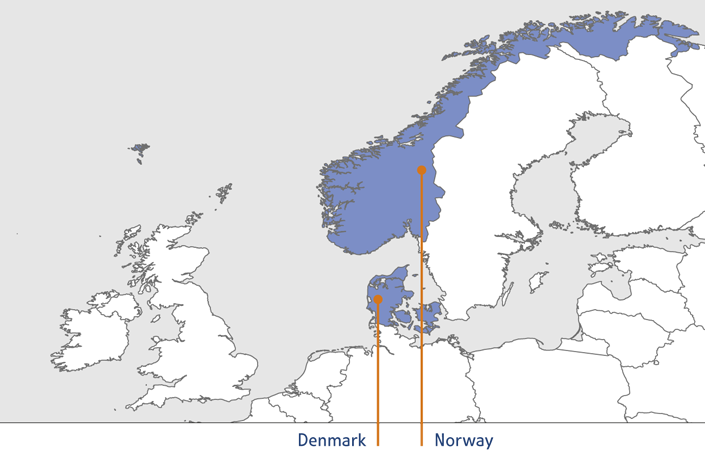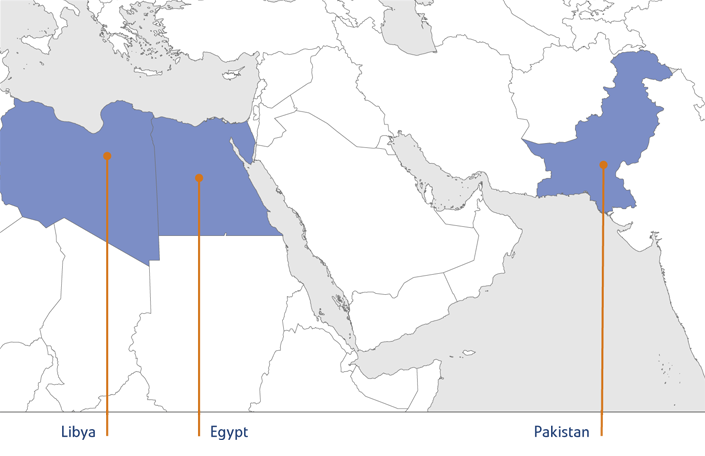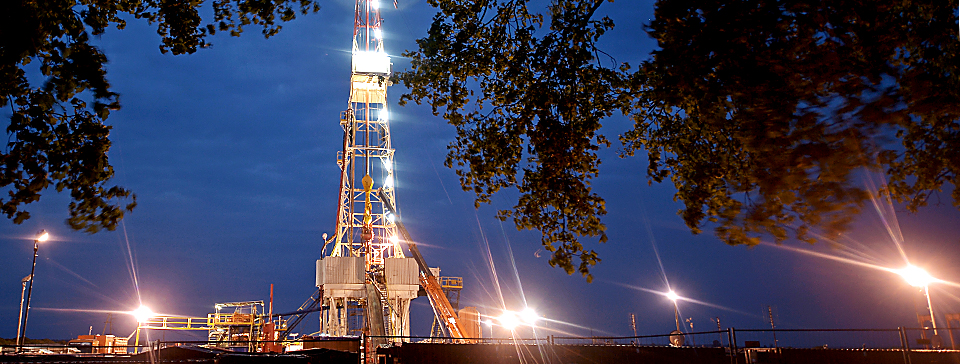Foreign licences

Denmark
| Licence: | 1/05 |
|---|---|
| Interest holders: | PGNiG (80%) |
| Nordsofonden (20%) |
Since the execution of the agreement for assignment of interests in 2007, PGNiG has been engaged in exploration activity in the 1/05 licence area in Denmark. Ultimately, the licence interests were: PGNiG (operator) – 80%, Nordsøfonden – 20%. Drilling of the Felsted-1 exploration well was completed in early 2012. As the well did not flow hydrocarbons at commercial rates, it was abandoned. However, as the first attempt to plug the well was unsuccessful. PGNiG obtained a consent from the Danish Energy Agency (DEA) to extend the licence term. The well was finally abandoned; the 1/05 licence was allowed to expire, and a decision was made to liquidate the Denmark Branch by the end of the first half of 2013.
Norway
| Licence: | PL159, PL212, PL212B, PL212E, PL262 |
|---|---|
| Interest holders: | PGNiG Norway (11,9%) |
| BP Norge (23,8% – operator) | |
| Statoil Petroleum (36,2%) | |
| E.ON Ruhrgas Norge (28,1%) |
Towards the end of 2012, PGNiG Norway, together with its partners, launched production of crude oil and natural gas from the Skarv, Idun and Snadd fields. Thus, PGNiG became the first Polish company to produce significant volumes of oil and gas under an international project. The project was also PGNiG’s first offshore production venture.
The Skarv field is located in the Norwegian Sea, approximately 210 km west off the coast of Norway, where the depth ranges between 350 metres and 450 metres. It was discovered in 1998 and its recoverable reserves are estimated at 57.1 bn m³ of gas, 16.5 m m³ of crude oil and condensate, and 7.8 m tonnes of NGL (or 576 m barrels of crude and gas equivalent). PGNiG Norway holds an 11.9% interest in these reserves, or 68.6 m barrels of crude and gas equivalent.
The Skarv project is considered one of the largest investment projects under way in Norway. It involves the drilling of 17 deep wells, including 7 oil producers (horizontal wells), 6 gas producers and 4 injectors. At a later stage, the injectors will be converted into gas producing wells.
The field is exploited using a new geostationary floating production, storage and offloading vessel (FPSO). The FPSO, built in South Korea, is the largest FPSO vessel in the world, able to operate in rough weather conditions. Its hull is 292 metres long and 52 metres wide. The vessel’s capacity is 140 ths m³ (880 ths barrels). The expected load capacity of the shuttle tankers operating on the Skarv field will be approximately 135 ths m³ (850 ths barrels).
| Licence: | PL521 |
|---|---|
| Interest holders: | PGNiG Norway (35%) |
| Statoil (40% – operator) | |
| Statoil Petroleum (36,2%)Svenska Petroleum Exploration Norge (25%) |
The licence was awarded in the 20th licensing round. It is located within the Helgeland basin. The Helgeland basin, which lies in the eastern part of the Norwegian Sea, has not been subject to any major exploration work so far.
From 2010 to the end of 2012, new 3D seismic was acquired, processed and interpreted, whereupon geological and geophysical analyses were performed in order to determine whether a well should be drilled or the licence dropped).
The decision is due in the first half of 2013. The licence is operated by Statoil.
| Licence: | PL558 |
|---|---|
| Interest holders: | PGNiG Norway (30%) |
| E.ON Ruhrgas Norge (30% – operator) | |
| Det norske oljeselskap (20%) | |
| Petoro (20%) |
The licence, awarded in the APA 2009 licensing round in early 2010, is located in the immediate vicinity of the Skarv field. The close vicinity of the Skarv FPSO is likely to ensure profitable export of the gas and crude oil to be produced in the PL558 licence area.
Since the award of the licence, the existing 3D seismic profiles have been reprocessed and interpreted, and additional geological studies have been performed, confirming the prospectivity of the area. The area covered by the licence has considerable exploration potential, with crude oil and natural gas reserves likely to be discovered. At the beginning of 2012, the licence’s interest holders resolved to drill an exploratory well. The drilling is scheduled for 2014.
The licence is operated by E.ON Ruhrgas Norge.
| Licence: | PL599 |
|---|---|
| Interest holders: | PGNiG Norway (20%) |
| BG Norge AS (40% – operator) | |
| Idemitsu Petroleum Norge AS (20%) | |
| Norwegian Energy Company ASA (20%) |
| Licence: | PL600 |
|---|---|
| Interest holders: | PGNiG Norway (30%) |
| Dana Petroleum Norway AS (70% – operator) |
PGNiG Norway was awarded the PL599 and PL600 licences by the Norwegian Ministry of Hydrocarbons and Energy in April 2011, following conclusion of the 21st licensing round. Both licences are located within the Vøring basin, in the western part of the Norwegian Sea, in the immediate vicinity of the Aasta Hansteen gas field.
Under the licences held, PGNiG Norway and its partners undertook to reprocess the existing 3D seismic data. Based on the advanced seismic processing, as well as planned geological and geophysical surveys, it will be possible to assess the prospectivity of the area to make a “drill or drop” decision. The decision is due in 2013. If a decision to drill is made, the interest holders should drill a well within four years of the award date.
| Licence: | PL646 |
|---|---|
| Interest holders: | PGNiG Norway (20%) |
| Wintershall Norge (40% – operator) | |
| Lundin Norway (20%) | |
| Norwegian Energy Company (Noreco – 20%) |
At the beginning of 2012, PGNiG Norway acquired interests in licence PL646 in the Norwegian Sea. The licence area is adjacent to the Skarv field, which is in line with the company’s strategy. PGNiG Norway focuses its operations on key areas, such as the Skarv field, where it builds its position.
Since the award of the licence, 3D seismic profiles have been purchased and interpreted, and additional geological studies have been performed, confirming the prospectivity of the area. A decision whether to continue the work is due in the first quarter of 2014. If a decision to drill is made, the interest holders should drill a well within four years of the award date.
| Licence: | PL648S |
|---|---|
| Interest holders: | PGNiG Norway (50% – operator) |
| OMV Norge (50%) |
The PL648S licence is of special importance, because for the first time ever PGNiG has assumed the highly responsible role of operator on the Norwegian Continental Shelf. Having been granted the status of licence operator marks an important step for the PGNiG Group. For us, this is the first operatorship of a project of offshore exploration for crude oil and gas; it emphasises PGNiG Norway’s role as the PGNiG Group’s competence centre for offshore operations.
The licence area is adjacent to the Skarv field. The acreage has huge exploratory potential, with probable discovery of natural gas. New 3D seismic was acquired over the licence area, and is currently being processed. The partners will also carry out geological and geophysical analyses in order to assess the prospectivity of the area.
A “drill or drop” decision is due in the first quarter of 2014. If a decision to drill is made, the interest holders should drill a well within four years of the award date.

Libya
| Licence: | blok No. 113 |
|---|---|
| Interest holders: | PGNiG (100%) |
In February 2008, POGC-Libya signed an Exploration and Production Sharing Agreement (EPSA), enabling the company to carry out exploration work on Exploration and Production Licence No. 113 with an area of 5.5 ths sq km. The licence is located within the Murzuq crude oil basin, in western Libya.
When the civil war in Libya broke out in February 2011, all non-Libyan personnel of POGC-Libya were evacuated from the country. In March 2011, a notice of a force majeure event was filed with the National Oil Corporation, as a result of which performance of the EPSA was suspended. In 2012, POGC – Libya BV reopened its Tripoli office and commenced implementation of safety procedures necessary to ensure safety of employees of the Tripoli branch office and of field workers. In the second half of 2012, the force majeure event was declared to have ceased and exploration work was resumed. At the time of resuming the work, the company obtained all necessary drilling permits and ordered performance of preparatory work related to the planned drilling activities.
Egypt
| Licence: | Bahariya |
|---|---|
| Interest holders: | PGNiG (100%) |
In Egypt, PGNiG conducts exploration work in the Bahariya licence area (Block 3) under an Exploration and Production Sharing Agreement (EPSA) executed with the government of Egypt on May 17th 2009. The Company holds a 100% interest in the licence. In 2012, the acquisition of 2D seismic data (in total, 2,300 km) was completed, with the 2D seismic image processed and interpreted. The first exploration wells are expected to be drilled in the first half of 2013.
Pakistan
| Licence: | Kirthar |
|---|---|
| Interest holders: | PGNiG (70%) |
| Pakistan Petroleum Limited (30%) |
PGNiG conducts exploration work in Pakistan on the basis of an agreement for hydrocarbon exploration and production in the Kirthar licence area, executed between PGNiG and the government of Pakistan on May 18th 2005. Work in the Kirthar block is conducted jointly with Pakistan Petroleum Ltd., with production and expenses shared proportionately to the parties’ interests in the licence: PGNiG (operator) – 70%, Pakistan Petroleum Ltd. – 30%. In 2012, workover of the Hallel-1 borehole was completed, as was the drilling of the horizontal Hallel-X1 borehole. After a gas flow was obtained from the well, work was begun to build facilities necessary to perform a double-well production test on the Rehman-1 and Hallel-X1 wells. Additional interpretation of 3D seismic data was undertaken, confirming the presence of potential deposits in the northern part of the licence area. On July 6th 2012, the Pakistani licensing authority (Directorate General of Petroleum Concessions) classified the Rehman field as a deposit of unconventional tight gas. In consequence, the interest holders can raise gas prices by 50% relative to the price of gas produced from conventional reserves. Following valuation of the Kirthar licence performed by Canadian firm DeGolyer&McNaughton, in 2012 the operator decided to move to the second exploration stage as part of which a new exploration well is to be drilled by August 2014.






